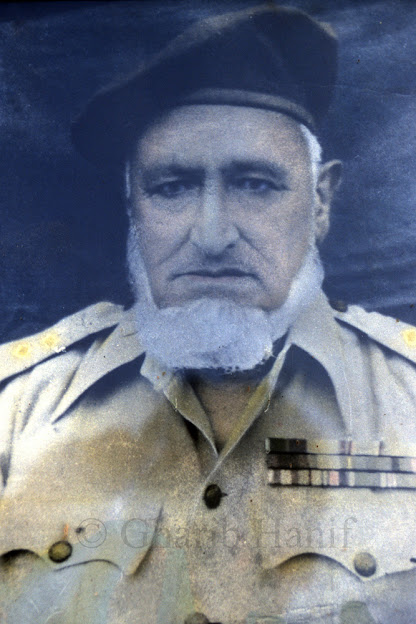Hast-o-Bood Part-32
Chapter IV
Historical background and brief overview of the
state of Jammu and Kashmir
Now the axis of jihad was the area of Colonel Raja Muhammad Mahmood Khan, Gulpur, Tharoch and Khatkali, within which the stronghold of Tharochi was the last colonial symbol of the Dogra government in this area. There were two platoon forces in this fort. One platoon consisted of Muslim soldiers and officers while the other platoon was led by Captain Prem Singh Gorkha. But the two officers in the Muslim platoon were Colonel Muhammad Hussain and Commandant Colonel Rehmatullah. In this respect, the top leadership of each of the two platoons was with Colonel Rehmatullah, who summoned Colonel Raja Muhammad Mahmood Khan to Fort Tharochi. Raja Sahib already knew Colonel Rehmatullah well. So they went to him without fear or danger. He requested Raja Sahib for supplies and food. Which was provided by Raja Sahib under the spirit of Islamic brotherhood and goodwill. He was also asked to contact the local Hindu population for food supplies. Therefore, under the same pretext, he kept reviewing the situation in the whole area and also gave orders after being properly informed about the activities of his organization according to the situation. One day he was returning from Sahansa with information about his position when on the way one of his confidants told him that the enemy had evacuated the fort of Tharochi. At that time there were only five military Mangral pensioners with Colonel Raja Muhammad Mahmood Khan. Instead of going to his home in Mouza Khatkli, he climbed the hill fort of Tharochi from the south and entered, but he could not find anyone inside the fort except a few cannons and a small quantity of ammunition. Considering himself to be an unseen support, he considered it a good omen and immediately tore his cloak and made a flag. At the same time, the six veterans saluted the flag of freedom. Hearing the roar of the cannons, Subidar Khushal Khan and Major Muhammad Hussain from Sahansa also came to Tharochi and reached the fort and congratulated the Colonel.
It was reported at night that the Dogra army, which had left the fort of Tharochi safe in its knowledge to strengthen its position in the northern region, was returning with full equipment for the conquest of the fort after hearing the roar of cannons. ۔ At that time Colonel Sahib and eight men with him were present in the fort. And they also had weapons. As soon as the two officers of Sahansa's forces heard this news, Sahansa left. Colonel Sahib sent one of his companions, a Mangral soldier, to help at Kotli Mangrallan, 12 miles from here, and a group of five men, led by Colonel Sahib, stayed to protect the fort and the flag. As soon as the morning dawned, the Colonel and his companions saw the soldiers and officers of the two enemy companies climbing the hill of Fort Tharochi from three sides, quietly taking advantage of the darkness to kill at night. Realizing the seriousness of the situation, Colonel Sahib's sixth sense advised him and his companions to immediately flee from the only empty side of the fort. This was done so neatly that the Dogra army did not even have the illusion of who had occupied the fort and hoisted the flag. Colonel Sahib had reached his adjoining hill at Dera Dhok Gohra Behaliyan (Mouza Khatkali) with his companions before dawn and was assessing the movement of the enemy from there. A few hours later, the aid of 27 soldiers from Kotli Mangaral had reached Colonel Sahib under the leadership of Muhammad Iqbal Butt. But since these young men had arrived late, the defense of the fort and the battle could not take place. And now the Colonel had no choice but to resort to strategy and to take appropriate action at the right time, because with a small force of his own, to fight an army many times better equipped than his own would be fatal. Doing so was tantamount to suicide.
to be continued .....
[Note: One thing that is very surprising here is that the author is forgetting Colonel Sahib's right wing Lieutenant Raja Karam Dad Khan Ghazi Kashmir in his book. Lieutenant Raja Karam Dad Khan was not only Colonel Sahib's right wing man but also one of the founders of 11 AK Battalion, who accompanied Colonel Sahib from time to time. The author is going to Sahansa from Saharmandi and on the way from Sahansa to Saharmandi back to Gulpur these areas are mentioned again and again but Lt. Karam Dad Khan is not present in this mention even though in 2015 a special magazine from GHQ published with Lt. Dad Khan Ghazi Kashmir was photographed and mentioned by GHQ which I saw and read myself. This magazine is preserved by Raja Aftab Hussain Puta Sahib and Raja Sarfraz Ahmad Khan has reflected it in his book in 2016. Let the reader guess why the author did this. Was there no scientific betrayal? These are just questions, not suspicion, because I do not think that the late Colonel Sahib did not mention Lieutenant Karam Dad Khan to the author in his statement.]
Note: Blogger does not necessarily agree with the text of the book.



Comments
Post a Comment